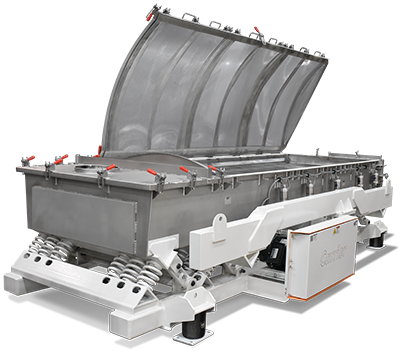Screen, Scalp, Dewater, Or Separate Bulk Solids Materials
Ideal for dry or wet screening, Carrier’s vibratory screeners can handle up to 1500 tons per hour, with many deck design options and various screening media that deliver maximum efficiency. Our vibratory screeners can be manufactured with customizable construction and configuration to meet your needs.
Vibratory screener design options:
- Designed to accommodate up to five decks on a single vibratory screener unit.
- Available in single, double, or triple deck designs.
- Grease or oil lubrication bearing system options.
- Tuned, two-mass, natural frequency, and brute force designs.
- Available in widths from 6 inches to 10 feet and lengths up to 200 feet.
- Available with side, end, intermediate, straight, or bias discharges.
- High-temperature vibratory screener designs available for handling materials up to 2000 deg. F.
- Choice of vibratory screener construction from carbon steel to metal alloys.
- Options include removable dust-tight covers, overhead drive arrangements, liners, explosion-proof designs, etc.
- Available in fixed or adjustable rate designs.
- Supported from below or suspended from above on soft steel coil or rubber isolation springs to reduce dynamic reactions to surrounding structures.
Features & benefits of Carrier vibratory screeners:
- Ideally suited for wet or dry screening.
- Capacities range up to 1,500 tons per hour.
- Designed for the highest possible screening efficiency.
- Circular motion for increased screener efficiency – our vibratory screener units feature a two-bearing design.
- Easy installation, low maintenance, and minimum downtime.
- Economical in initial cost and operation.
- Carrier vibratory screeners are also available with elliptical motion drives that can solve difficult screening problems. This motion provides a high rate of travel at the feed end, providing a thin material bed and rapid stratification, which separates the fines quickly. At the discharge end, the material flow is retarded, giving near-size particles additional time to pass the screen. Capacities range up to 500 tons per hour.







